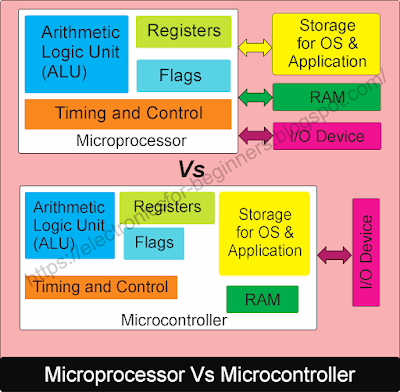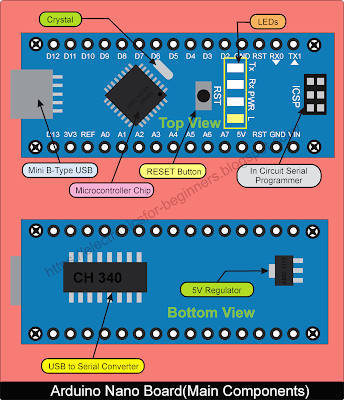 |
We are surrounded by embedded systems any where we go. Any electronic gadget you see around you or any electrical home appliance or machine that has option to take input from switches, push buttons, rotating knobs or sensors and providing output in any form like LCD display, LED indications or operating motor etc., contains a small embedded system in itself that is programmed for specific task that the system performs. Some examples are your coffee machine, smart watch, microwave oven, washing machine, refrigerator, music system, IoT (Internet of Things) devices etc. All of these devices contain an embedded computer on its circuit. So, what are embedded systems, what they contain or how they are build.
The heart of an embedded system is a microcontroller or a small computer with an embedded software inside it, that decides how and what type of inputs it will take from outer world & how and what outputs it will deliver based on the embedded program inside it. We will further see what is microcontroller. Other components are power supply, input devices, output devices etc. Before going deep into embedded system let us see basic of microcontroller and microprocessor. These are not same, there are differences. So, what is the difference between microprocessor and microcontroller.
 |
Lets us understand from this diagram which shows a microprocessor on top that has common parts ALU, timing and control circuit, registers and flags etc. ALU performs the processing of data reaching the processor, registers hold the data bytes temporarily and flags hold status in form of bits ('0' & '1') that decide some way the processor will operate. Timing and control part generate signals that help handshaking with surrounding devices like storage, RAM and I/O device. Storage for OS and application is outside processor and RAM for temporary storage is also outside processor. Simplest example is your PC (Personal Computer) or Laptop. It has a main mother board that contain processor and RAM and other supporting components. A hard disk is connected to mother board that contain the operating system to boot the device. And then what ever applications are installed on OS, can be executed as per user choice. But in case of a microcontroller the storage for OS & application and RAM, is within the processor chip, only I/O devices are to be connected externally and should be powered from external source. Hence OS and application are to be burnt inside the chip via programmer kit and software.
 |
There are multiple manufacturers who makes micro-controllers like Microchip, NXP, Renesas, Infineon, Texas etc. They range from 8 bit to 32 bit processing capability. This means we can have controllers which can process 8 bit of data at one time, similarly 16 bit and 32 bit processing capability. They are mostly RISC (Reduce Instruction Set Computer) based processors architecture that operate on small set of instruction to reduce load on small processors.









0 Comments